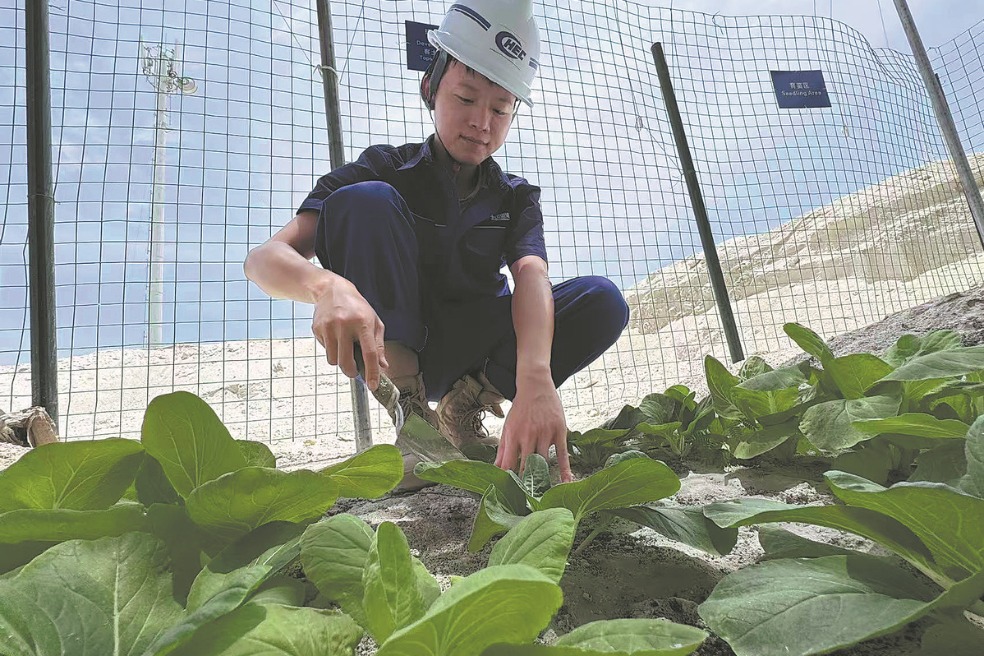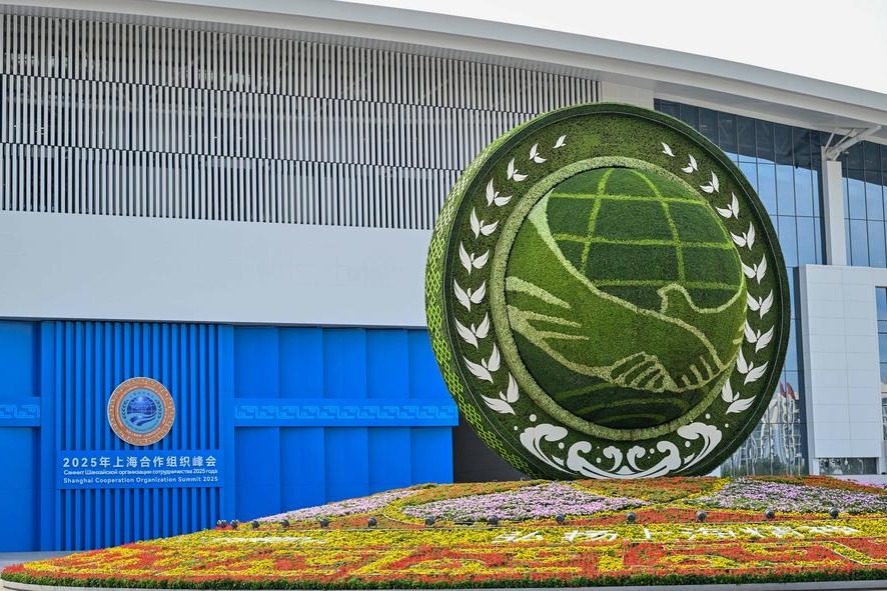Digital caves bring history alive
Past and present merge into a fascinating and educational presentation of ancient legacies, Fang Aiqing reports in Dunhuang, Gansu.

For more than a century, the Library Cave, or Cave 17 of the Mogao Caves of Dunhuang, in Northwest China's Gansu province, has been famous for its extraordinary collection of relics and a tale that has had its share of twists and turns.
For many who have had their curiosity piqued and want to know more about its legendary past, the Gobi Desert and the arduous journey to get there has deterred them from visiting to see for themselves the grandeur of the Dunhuang frescoes, while preservation requirements have resulted in limits on the number of visitors allowed access.
However, the Digital Library Cave, launched by the Dunhuang Academy in conjunction with technology company Tencent on April 18, International Day for Monuments and Sites, joins an array of measures that give the public the chance to get a virtual glimpse of the ancient wonder.
With technological solutions and narratives that are usually applied in digital games, it provides an immersive, interactive experience with not only a representation of the physical grottoes, but also historical scenes re-created, based on the joint input of scholars and engineers.
Su Bomin, director of the academy, says: "The project has enabled the relics to come alive with new means of expression. It makes the value of these relics more accessible to the audience, especially the younger generation."
Miraculous discovery
When Taoist priest Wang Yuanlu accidentally discovered the Library Cave and opened the entrance of the sand-buried treasure trove in 1900, more than 60,000 Buddhist manuscripts, documents pertaining to government and social economy, silk paintings, embroidery and sacred articles, among others, were brought to light after nearly 1,000 years of isolation.
Rows of scrolls, dating from the 4th to the 11th centuries, piled up from floor to ceiling in the square chamber, which is 2.6 meters in length and width and 3 meters in height, making it one of the most important archaeological discoveries of the 20th century. It is regarded as one of the four major discoveries of ancient Chinese documents.
However, most of these relics were taken overseas, held in museums in London, Paris, Tokyo and St. Petersburg.
Today, in Cave 17, a painted statue of Hongbian, chief of monks and a politically influential figure when the cave was built in the mid-9th century, said to be the owner of the cave, sits on a bed of earth, meditating.
The mural behind him depicts two Bodhi trees with a fabric bag and a water flask hanging on the branches. Also shown are a Buddhist nun with a silk fan in hand and a female follower wearing the clothes of a man, holding a scepter and a towel. The west wall of the cave is embedded with a stele inscribed with stories of Hongbian's life.
The statue, which is believed to be a true-to-life portrayal of Hongbian, was originally found in Cave 362, nearly three stories above Cave 17.
In the 1960s, Chang Shuhong (1904-94), the first director of the Dunhuang Academy, suggested relocating the statue to Cave 17, which, as it turned out, seemed to fit the "new" setting perfectly. This indicated that the statue was very likely placed there originally, but moved to the upper cave to make room for the manuscripts at some point later.
In the digital tour, a view of Cave 17 filled with ancient treasures — as it looked when it was originally unearthed — and what it looks like today, can both be seen.
In-game learning
Just like in a game, the audience plays the role of a time-traveling explorer and, under the guidance of Mogao Caves' digital ambassador Jiayao, participates in, and witnesses the passing of the millennium, from when the cave was built, sealed and rediscovered, to how the relics were lost or scattered, and reunited virtually.
During the process, the audience will meet eight non-player characters, all real historical figures, including Hongbian and Wang, the controversial Taoist priest.
"The Digital Library Cave is a combination of art, academic research and technology," says Li Hang, vice-president of Tencent's Corporate Marketing and Public Relations, adding that it lowers the threshold required to learn about the cave and the relics, therefore extending the reach of the site to a wider audience.
According to Li, the project has facilitated the creation of a "digital twin" of the 1,600-meter-long external cliff face of the Mogao Caves and its 16th and 17th caves that is accurate to the millimeter, as well as exact digital re-creations of the murals, statues and relics housed there.
The surroundings are dotted with indigenous plants, and the exploration experience is accompanied by pieces of background music played with traditional instruments like pipa (a four-stringed lute), bili (a double-reed pipe) and drums, all of which can be seen in the murals at Dunhuang.
Alongside the use of high-definition digital scanning, the project also involves physically based rendering, a technical approach for better game rendering, to realize dynamic lighting conditions.
For example, Li says, the passages and murals in the digital caves are illuminated by the sun in its position at 10 am, whereas in reality, to facilitate conservation, the caves are kept in low light, and visitors have to scrutinize the murals and statues simply with what little light emanated from outside or with the help of a flashlight.
Game technologies have shown great potential in preservation, display and research of cultural relics, says Cui Xiaochun, vice-president of Tencent's Interactive Entertainment Business Group, which participated in the development of the digital caves.
He says, they've been accumulating a set of tools and production methods to form a paradigm that can involve more cultural institutions nationwide and accelerate the digital conservation of relics and creative applications of these digital legacies.
Rigorous approach
In the digital version of the caves stands the Sanjie Temple, a well-known nearby historical site that no longer exists.
According to Zhao Xiaoxing, director of the Dunhuang Textual Research Institute, Dunhuang Academy, scholars speculate that the manuscripts found in Cave 17 were part of a 10th-century large-scale sutra restoration project at the temple. Some of them might be materials used by the monks to repair the manuscripts.
Zhao wrote the scripts and storyline for the game, based on the academy's decades of research.
The several-second presentation of the 3D model temple took the technological team months of effort. When it was almost completed, it fell over, and the team had to start over.
Zhao explains, the original design was so grand that it looked more like an official temple in cities such as Chang'an, today's Xi'an in Shaanxi province, and Luoyang, Henan province, and, as such, didn't fit the surroundings of the Mogao Caves.
They then worked with the academy's ancient architectural expert Sun Yihua, reexamined historical references and adjusted the design, from the layout to the main body of the architecture, and even the orientation of the statues on both sides of the pagoda gate.
A large group of young scholars at the academy, specializing in various fields like literature, art, music and dance, archaeology and new media technologies, have been participating in the digital cave project, with meticulous verification of every scene and detail, Zhao says.
The game can be accessed either on the website Digital Dunhuang, or via the WeChat miniprogram, Cloud Museum of Dunhuang Caves.
According to the two organizations, in the near future, Digital Library Cave will be available in multiple languages, including English, Japanese and Korean, as this year marks the 10th anniversary of the Belt and Road Initiative, and Dunhuang, sitting in the Hexi Corridor, the main artery of the ancient Silk Road, historically served as a vital crossroads for trade, religious and cultural exchanges.





Today's Top News
- Overhaul pledged after pre-made meal controversy
- US push on tariffs condemned
- Promoting international rule for fairer global governance
- Madrid talks show negotiations remain the best way forward: Editorial flash
- China, US reach basic consensus on TikTok
- Nation's growth steady amid headwinds































